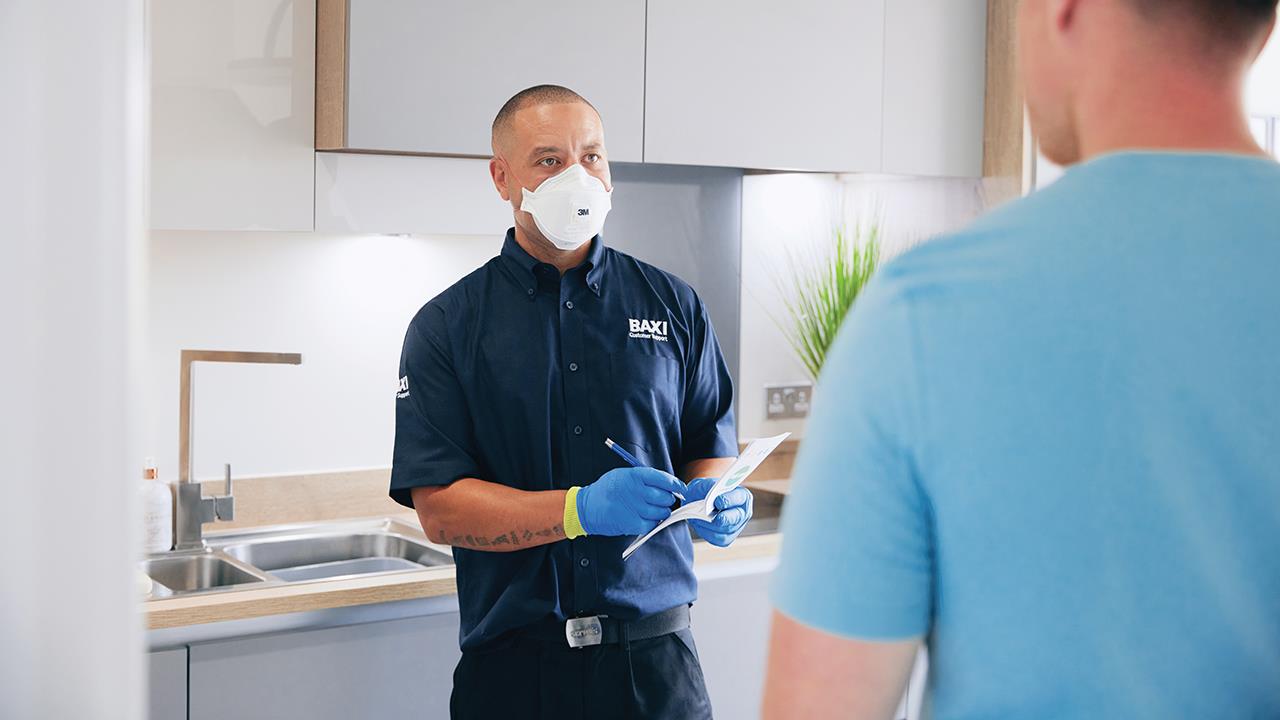

As the heating industry knows well from past experience, maintaining health and safety in customers’ homes is vital.
Compared with a building site, where the requirement for personal protective equipment (PPE) is usually much clearer, deciding what precautions to take when entering the home environment can be more of a grey area for plumbing and heating engineers.
The following guidelines highlight how best to maintain a safe and secure working environment at all times.
Take it from the top
As well as offering vital protection from the COVID-19 virus, wearing a mask at all times when working in a customer’s home can help prevent the inhalation of dust and debris, which can lead to respiratory issues over time.
For the best defence, and to limit creating more waste, avoid using disposable paper masks and, if possible, buy a reusable one that can be washed thoroughly between uses.
In addition to wearing a face covering, it is a good idea to invest in some form of protective headwear, to avoid bumps and injuries. While hard hats are the norm on building sites, bump caps may be a better option for working in customers’ homes. These look less like PPE but can still help limit the impact of hitting your head against low shelves, under sink pipework, or in the attic.
Debris or hazardous substances can also pose a risk of serious eye injury or, in worst case scenarios, even cause blindness. Wearing appropriate safety glasses is one of the best ways to shield eyes from dust chips or flying particles.
When working with chemicals, such as inhibitors, opting for safety glasses with all-round protection is recommended to prevent any harmful substances reaching the eyes.
Protecting the upper body
To avoid cuts, scrapes, punctures, chemical erosion, or heat burns when working on a system, consider wearing safety gloves.
Though there may be a concern that gloves can limit movement, a good pair of gloves will be manufactured with dexterity in mind, so should be suitable for carrying out delicate work.
It is easy to find the right fit by trying on a few different designs and sizes before purchasing. It is also worth checking the cut protection level rating of safety gloves, as this can range from one (being the lowest) to five (offering the highest cut resistance).
For plumbing and heating engineers, level five gloves are recommended to ensure maximum protection from sharp blades and glass.
There are other considerations that might affect the choice of gloves too. For heavy lifting jobs, such as moving an appliance or heat exchanger, rigger gloves can guard against cuts and grazes, while maintaining grip.
It is also worth remembering that arm protection, such as armlets, can be used with gloves, especially when reaching into boiler systems or for hard to access pipes.
In instances where coming into contact with system water, chemicals, or contaminated surfaces is likely, nitrile gloves can also be worn over safety gloves to stop them becoming wet or contaminated.
In addition, nitrile gloves can offer bacterial and viral protection – just remember to wash your hands before, after, and at regular intervals throughout the job as an extra precaution.
Lower body protection
Unfortunately, knee problems are common among tradespeople, especially those with years of experience behind them. It is therefore worth investing in PPE measures as soon as possible to stay injury free and prevent existing problems from escalating.
When working on the floor, knee pads and kneeling mats can help cushion joints, and prevent future ligament damage, which is often caused by repetitive bending and muscle strain.
To protect feet, safety shoes with steel-reinforced toe caps and puncture-resistant soles are vital PPE kit. Wearing the correct boots can also help prevent injuries from heavy falling objects and concealed hazards, like hidden nails.
When working in a customer’s home, shoes often need to be removed to keep flooring clean, so carrying non-slip, overshoe covers is always a good idea. That way, if asked to remove footwear, it is possible to keep wearing safety shoes while protecting carpets from dirt at the same time.
Assessing risks
Health and safety is a crucial matter and, while PPE can protect the body from a multitude of hazards and injuries, vaccination and regular testing are the most important protections against the pandemic, as well as means to reassure costumers that they too are safe when inviting a tradesperson into their home.
It is however also worth assessing potential risks at the beginning of every job. To help achieve this, we recommend speaking to customers over the phone before agreeing to do a job, in order to determine whether they, or any other inhabitants at the property, have shown any symptoms of COVID-19, are self-isolating, or are classed as vulnerable.
If the occupants are healthy and you are completely comfortable, only then should you carry out the work, while using the correct PPE and following latest guidelines for COVID-19 safety.
If you'd like to keep up-to-date with the latest developments in the heating and plumbing industry, why not subscribe to our weekly newsletters? Just click the button below and you can ensure all the latest industry news and new product information lands in your inbox every week.